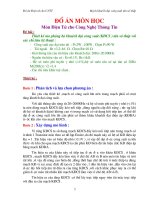Thương mại điện tử ngành công nghệ thông tin TMDT 10,12,14
Bạn đang xem bản rút gọn của tài liệu. Xem và tải ngay bản đầy đủ của tài liệu tại đây (25.53 KB, 1 trang )
Le Ho Lan Vy_205081780
10. What is conversational commerce and how does it relate to mcommerce?
Conversational commerce can be seen as a vehicle for companies to
engage with consumers. It involves using chatbots on mobile messaging apps
such as Facebook Messenger, WhatsApp, Snapchat, and Slack.
Conversational commerce relates to m-commerce as it is known as a
variation of m-commerce.
12. Define disintermediation and explain the benefits to Internet users of
such a phenomenon. How does disintermediation impact friction-free
commerce?
+ Summary (definition of disintermediation): Disintermediation is the
displacement of market middlemen who traditionally are intermediaries
between producers and consumers by a new direct relationship between
producers and consumers.
+ Disintermediation impacts friction-free commerce by resulting in the
visions of intense competition, the decline of intermediaries, lower
transaction costs, and a reduction in unfair competitive advantages.
More detail about disintermediation: For merchants, the cost of searching
for customers would also fall, reducing the need for wasteful advertising. At
the same time, advertisements could be personalized to the needs of every
customer. Prices and even costs would be increasingly transparent to the
consumer, who could now know exactly and instantly the worldwide best
price, quality, and availability of most products. Information asymmetry
would be greatly reduced. Given the instant nature of Internet
communications, the availability of powerful sales information systems, and
the low cost involved in changing online prices (low menu costs), producers
could dynamically price their products to reflect actual demand, ending the
idea of one national price, or one suggested manufacturer’s list price. In turn,
market middlemen—the distributors and wholesalers who are intermediaries
between producers and consumers, each demanding a payment and raising
costs while adding little value—would disappear (disintermediation)
14. What is driving the growth of social e-commerce?
The growth of social e-commerce is being driven by a number of factors,
including the increasing popularity of social sign-on (signing onto websites
using your Facebook or other social network ID), network notification (the
sharing of approval or disapproval of products, services, and content), online
collaborative shopping tools, social search (recommenda- tions from online
trusted friends), and the increasing prevalence of integrated social commerce
tools such as Buy buttons, Shopping tabs, marketplace groups, and virtual
shops on Facebook, Instagram, Pinterest, YouTube, and other social networks.









